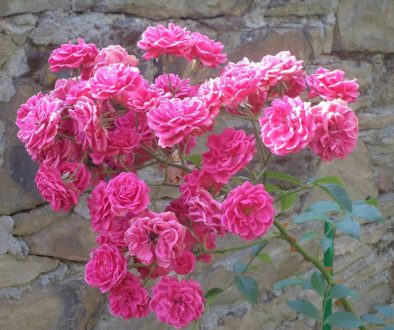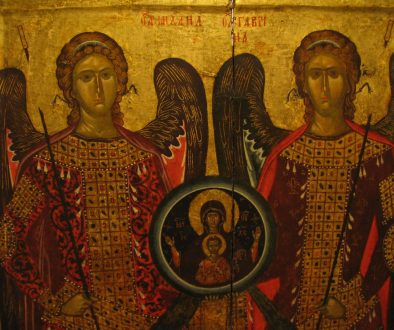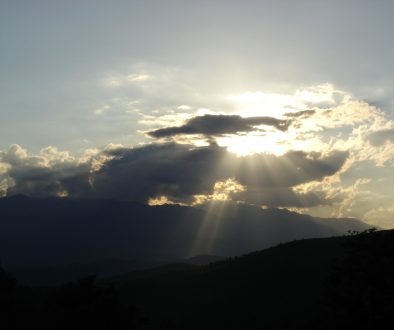The bulgarian Feasts presented by Trekking BG
Nova Godina (New Year)
 A winter holiday, known through the whole territory of Bulgarian ethnicity for its large number of rituals. It is related to an important natural turning point – the day of the winter equinox – which makes it perfect for fortune telling and rites. After the table is incensed with coal on a roof tile, the most senior person in the house lifts high the rite bread, splits it into pieces and gives a piece to everybody by order of seniority. The dish with the banitza (cheese pastry) is whirled three times and everybody gets the piece in front of him with a little gift of fortune inside. The rest of the banitza is kept “for the Holy Mother”. Around the fire and the table fortune telling goes on about the strokes of luck in the New Year. Before dawn the custom of sourvakane starts. This is a New Year specific custom carried out by young boys up to 15-16 years of age, having cornel twigs – sourvachki, sourvaknitzi, twigs decorated with coins, small ring-shaped buns, popcorn, multicolored ribbons and paper. In the New Year morning every boy flips his parents and relatives with the sourvachka several times and wishes them:
A winter holiday, known through the whole territory of Bulgarian ethnicity for its large number of rituals. It is related to an important natural turning point – the day of the winter equinox – which makes it perfect for fortune telling and rites. After the table is incensed with coal on a roof tile, the most senior person in the house lifts high the rite bread, splits it into pieces and gives a piece to everybody by order of seniority. The dish with the banitza (cheese pastry) is whirled three times and everybody gets the piece in front of him with a little gift of fortune inside. The rest of the banitza is kept “for the Holy Mother”. Around the fire and the table fortune telling goes on about the strokes of luck in the New Year. Before dawn the custom of sourvakane starts. This is a New Year specific custom carried out by young boys up to 15-16 years of age, having cornel twigs – sourvachki, sourvaknitzi, twigs decorated with coins, small ring-shaped buns, popcorn, multicolored ribbons and paper. In the New Year morning every boy flips his parents and relatives with the sourvachka several times and wishes them:
Sourva, sourva godina
Do godina sys zdrave
Do godina, do amina!(Happy New Year, Happy New Year, be healthy throughout the whole year, till the end of time!)
For their wishes, boys are rewarded coins, buns, sweets, etc. Usually, they go by themselves or led by an older man to express wishes to neighbors and relatives.
Trifon Zarezan (The Vine King)
 Every region has its specifics, but most celebrate 14 February as Trifon Zarezan, the so-called winegrowers’ saint. By tradition, everybody involved in the wine production, dressed in their nicest clothes and accompanied by musicians playing national instruments, goes to the vineyard. Many winegrowers carry symbolic flowers, wild geranium (for sound health) and box shrub (for longevity). People choose a leader of the feast, possibly the oldest or the best winegrower, and he opens the feast by symbolically trimming different vines and pouring wine on them to stimulate good crops. The trimmings are intertwined and men wear them around their shoulders. When people return to the village, wine is served to the leader of the feast and the other guests. Several drops of wine are traditionally dropped on the earth to stimulate the fertility of wines, as well as of the village. Feasts finish late at night.
Every region has its specifics, but most celebrate 14 February as Trifon Zarezan, the so-called winegrowers’ saint. By tradition, everybody involved in the wine production, dressed in their nicest clothes and accompanied by musicians playing national instruments, goes to the vineyard. Many winegrowers carry symbolic flowers, wild geranium (for sound health) and box shrub (for longevity). People choose a leader of the feast, possibly the oldest or the best winegrower, and he opens the feast by symbolically trimming different vines and pouring wine on them to stimulate good crops. The trimmings are intertwined and men wear them around their shoulders. When people return to the village, wine is served to the leader of the feast and the other guests. Several drops of wine are traditionally dropped on the earth to stimulate the fertility of wines, as well as of the village. Feasts finish late at night.
Baba Marta (Granny Martha)
 Baba Marta is one of the most honoured Bulgarian customs, preserved until nowadays. On this day everybody gives their relatives a special amulet, called martenitza, to bring health and might in the coming year. Martenitzas are made specially for the 1st March when the new agricutural year is believed to begin. Martenitzas are obligatorily made of two interwoven threads – a red and a white one. During the feast, everybody wears a martenitza openly. People wear it until they see a stork. Then they bury it in the earth, and after a while they try to predict the future by the little creatures gathered around it. Martenitzas are also hung in the orchard and on the cattle – for better crops and fertility in the coming year. Usually made of wool, martenitzas take the form of coins, blobs, tassels, etc. The while wool thread symbolizes long life and the red – health and power. This is easy to explain, because martenitzas are worn toward the end of the winter season, when vital energy and stored food are coming near end.
Baba Marta is one of the most honoured Bulgarian customs, preserved until nowadays. On this day everybody gives their relatives a special amulet, called martenitza, to bring health and might in the coming year. Martenitzas are made specially for the 1st March when the new agricutural year is believed to begin. Martenitzas are obligatorily made of two interwoven threads – a red and a white one. During the feast, everybody wears a martenitza openly. People wear it until they see a stork. Then they bury it in the earth, and after a while they try to predict the future by the little creatures gathered around it. Martenitzas are also hung in the orchard and on the cattle – for better crops and fertility in the coming year. Usually made of wool, martenitzas take the form of coins, blobs, tassels, etc. The while wool thread symbolizes long life and the red – health and power. This is easy to explain, because martenitzas are worn toward the end of the winter season, when vital energy and stored food are coming near end.
Zagovezni (Shrovetide)
The week before Lent is rich in interesting customs. The rituals for seeking forgiveness from parents, relatives, friends and neighbours are intertwined with pagan traces of honoring fire and feasts, similar to the games of Dionysus, the god of wine and drama.
 No meat is consumed throughout the whole week. The Sunday is known as Pokladi or Zagovezni (Shrovetide). Then young people visit their parents and relatives, and, after kissing the right hand of the older, ask for forgiveness of everything bad they did throughout the year. The older usually answer “You are forgiven”. After that the young give oranges, apples or eggs, if they do not have fruit. The Shrovetide dinner finishes with the custom of lamkane (biting). A boiled egg or a piece of white khalva are tied to a thread and hung from the ceiling above the table. After that they are rotated so that everyone can bite them. In the second part of the game somebody’s longevity is predicted. The thread is burned and the longer it burns, the longer the person shall live.
No meat is consumed throughout the whole week. The Sunday is known as Pokladi or Zagovezni (Shrovetide). Then young people visit their parents and relatives, and, after kissing the right hand of the older, ask for forgiveness of everything bad they did throughout the year. The older usually answer “You are forgiven”. After that the young give oranges, apples or eggs, if they do not have fruit. The Shrovetide dinner finishes with the custom of lamkane (biting). A boiled egg or a piece of white khalva are tied to a thread and hung from the ceiling above the table. After that they are rotated so that everyone can bite them. In the second part of the game somebody’s longevity is predicted. The thread is burned and the longer it burns, the longer the person shall live.
Todorovden (Todor’s day)
Horses’ health is honored on that day. Before the break of dawn women prepare ritual breads in the form of a little horse or a horseshoe and decorated with walnuts, garlic and salt. Every housewife gives out her bread while at the same time jumping and running, imitating the horses’ movement and sounds. Every woman sees tries not to remain the last. Ritual breads are also put into the horses’ nourishment. Corn is also given out for their health. Early on Todorovden mothers wash their children to ward off illnesses. Before the kushiya (horse race), women wash their hair with water with some straws from the horses’ stalls in it. The water is then poured on the street after the horses, so that women’s hair be long and strong like horses’ mane.
Velikden (Easter)
Easter is one of the biggest spring holidays, it is celebrated on the first Sunday after the first spring full moon and lasts for 3 days. Its place in the church calendar marks the new birth and blossoming of nature, the triumph of sun and life. People put an end to the fasts with a little egg and Easter bread. They exchange traditional greetings on the streets and crack their Easter eggs for health. Young couples visit their spiritual parents (krastnitzi) and the parents of the bride to bring them eggs and Easter pogachi (ritual bread). The hosts also give eggs. Maidens go to dance outside of the village. In folklore beliefs, this prevents the coming of dragons and elves and wards off serious diseases. The Holy Week finishes with Easter.
The Holy Week finishes with Easter.
Festive dishes: Easter bread, kozunak (sweet Easter bread), eggs, mekitza (fried pastry), milk, hen with onion, baked loukanka (flat sausage).
Easter Bread
Easter bread is prepared on the Saturday (or Friday) of the Holy Week. It is kneaded by the housewife, or, rarely, by the oldest woman in the family. The Easter bread obligatorily contains white flour, newly fermented yeast (prepared on the Holy Thursday), fat and an egg, added before it is baked. The Easter bread is never cut in slices, but is split in pieces by the number of the people round the table.
Gergyovden (St. George’s Day)
It is celebrated on the day of the Christian saint George who is believed to protect shepherds and cattle. In the spring night before the feast girls and maidens gather flowers and herbs in the meadows with which they ritually feed the sheep and cattle. Three wreaths are made: for the sheep to be milked first, for the lamb bestowed to the saint as gift and for the milk container. Houses, sheep pens, agricultural buildings and![]() vessels are garnished with spring greens. On Gergyovden a lamb is slayed everywhere as sacrifice for the saint. A big table is prepared for all village people somewhere “in the nature”, in the churchyard, outside the village. Besides the roasted lamb, other ritual food is brought also. At the sanctified table every woman distributes what she has brought. Around the table Georgyovden hora (dances) are played, led by the best shepherd or by a pregnant woman with a green tree branch. No salt or milk ferment is lended to prevent dark magic. Holy Martyr George is honoured both by Christians and Muslims.
vessels are garnished with spring greens. On Gergyovden a lamb is slayed everywhere as sacrifice for the saint. A big table is prepared for all village people somewhere “in the nature”, in the churchyard, outside the village. Besides the roasted lamb, other ritual food is brought also. At the sanctified table every woman distributes what she has brought. Around the table Georgyovden hora (dances) are played, led by the best shepherd or by a pregnant woman with a green tree branch. No salt or milk ferment is lended to prevent dark magic. Holy Martyr George is honoured both by Christians and Muslims.
Enyovden (Midsummer day)
In national beliefs, on this day the sun starts to die slowly and the year heads towards the winter. It is believed that those who see the sun washed in life-giving water early in the morning, will be healthy throughout the year. Everybody takes a close look at their shadow. If it turns out to be headless, or in half, this is a sign of illness. In the night of the dying and newborn sun different grasses and herbs acquire greatest healing power which disappears with the sunrise. That is why early in the morning on Enyovden, maidens and women, fortunetellers, witches and magicians gather herbs to be used for healing and magic during the year. On this night the waters also have magic power. It is believed that on this day the water of the rivers and wells is healing, because the sun has washed into it.
For fertility, on this day young women go to the field, harvest a wisp, make a rope of the wheat and cross the rope and the wisp. As a Christian holiday, Enyovden is associated with the birth of John the Baptist.
Koleda (Christmas)
Koleda is the holiday when the birth of the Christian God – Jesus Christ – is celebrated. This is the winter holiday richest in rituals and one of the greatest yearly holidays, known throughout the whole territory of Bulgarian ethnicity. The holiday is an original extension of Christmas Eve, because it begins from midnight – with the custom of koledouvane. Only men participate – bachelors, fiancee and newly married men. They choose a leader (stanenik, staretz) and organize themselves in groups of 10 to 15. The koledari are dressed in yamourluks (special gown) and have special boxtree decorations on their hats. They go round the houses from midnight until the morning. On the road, in front and in the house they sing special ritual songs, but with different motives, according to the place and person they refer to. Generally, they are ritual wishes for happiness in the family and good crops in the field. After the songs, the leader of the group who holds the Christmas bun given by the family, tells the special Christmas blessing (prayer, blagoslovka, slava):
Ot Boga mnogo zdrave, ot nas malko veselbica!
Lots of health from God, a little fun from us.
Koledouvane finishes with a common feast, where other men and women who also had koledari in their houses are invited.



